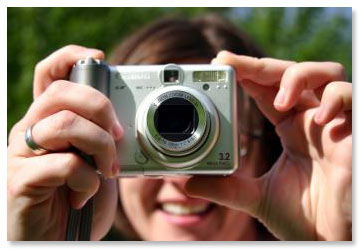|
|

How come a digital camera requires no film? How very convenient that there is no need to rush to a store to buy some films before every outing. :-)
Not to mention how it gives instant gratification right after pressing the shutter, because you can now view your captured digital photos through the LCD. This is instant feedback at its best.
So, what goes on inside that small piece of metal? How does the digital camera work in the background?
Let's take a closer look.
How a digital camera works compared to a film camera
Everything starts with light in photography, whether film or digital. But the difference comes as the photographer presses the shutter.
You see, unlike in film cameras where the light reaches a photosensitive film, the light entering digital cameras is focused by the lens onto the imaging sensors or chips.
On these chips are CCDs or charged coupled devices. The CCD is filtered or tuned to accept certain color images. Then it converts an image to digital format for processing and storing.
This puts the CCD at the heart of how a digital camera works.
To elaborate, a CCD is essentially a silicon chip used to measure light. Over the CCD is a processing circuitry and a collection of very small light-sensitive diodes, known as photosites, or pixels.
When the CCD is struck by light, these photosites convert the light (or photons) into electrical charges called electrons.
One pixel is made up of 1000 array receptors. And every pixel stores some information.The pixels are very much light sensitive, therefore the brighter light strikes them, the greater the build up of electrical charges or electrons.
Then the camera's ADC (analog to digital converter) converts these electrons to digital information.
Aside from the CCD, some low-end digital cameras use CMOS (complementary metal oxide semiconductor) technology as image sensors. You've probably heard of CMOS in relation to computers.
The advantages of CMOS include: one, it's cheaper than CCD. And two, CMOS sensors take less power consumption compared to CCD sensors. CCD based digital cameras eat up lots of battery power.
Unfortunately, the drawback of CMOS based cameras is that the image quality is not as high as that of a CCD based camera.
That's why nowadays, all cameras of the mega pixel range and above use CCD chips instead of CMOS for better image quality. They are more expensive, though.
Now, that's the first part of how a digital camera works. But what happens right after an image is converted to digital information?
Here's what happens next...
Right after the CCD converts an image to digital information, it usually stores it in a removable memory card (older digital cameras use built-in memory). The larger the capacity of your memory card is, the more digital photos you'll be able to store.
Then you normally transfer your digital photos from your camera to your PC through a USB cable.
All in all, whoever invented the digital camera has my eternal gratitude.
What a big convenience that I don't have to wait to complete a roll of film, then have it developed before I see the quality of my captured photos.
And knowing the basic of how my digital camera works makes me appreciate this amazing piece of technology even more.
Return from How a Digital Camera Works to the Home Page